Atlantic Salmon Characteristics
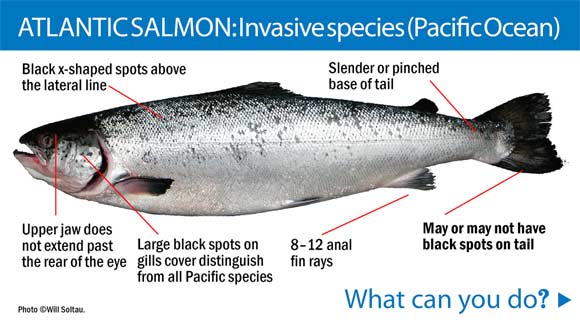
Atlantic salmon stands out with its unique characteristics that distinguish it from its Pacific counterpart. It is known for its light pink color, soft consistency, and mild flavor. The flesh of Atlantic salmon has larger flakes, making it perfect for various cooking methods. Unlike Pacific salmon, Atlantic salmon is commonly referred to by its country of origin, such as Norwegian salmon. Despite its milder taste, Atlantic salmon still provides omega-3s, protein, and other essential nutrients. Whether you prefer the delicate flavor and texture or the vibrant color and robust flavor, Atlantic salmon offers a delightful culinary experience.
Atlantic Salmon Flavor Profile And Texture
Atlantic salmon is known for its delicate flavor and buttery texture. Its flavor is mild, making it versatile and appealing to a wide range of palates. The flesh of Atlantic salmon has large flakes, giving it a firm yet tender texture. This allows it to hold up well to different cooking methods, such as grilling, baking, or poaching. Whether it’s the centerpiece of a dish or used in sushi, the flavor and texture of Atlantic salmon are sure to please seafood lovers. Its soft consistency and subtle taste make it perfect for various culinary creations.
Atlantic Salmon Nutritional Benefits
Atlantic salmon is not only delicious but also packed with nutritional benefits. It is an excellent source of high-quality protein, which is essential for muscle growth and repair. Additionally, it is rich in omega-3 fatty acids, which are known to promote heart health and reduce inflammation. Atlantic salmon also provides important vitamins and minerals, including vitamin D, vitamin B12, selenium, and potassium. These nutrients contribute to various bodily functions, such as bone health, immune function, and brain development. Incorporating Atlantic salmon into your diet can be a tasty way to improve your overall health and well-being.
Pacific Salmon Characteristics
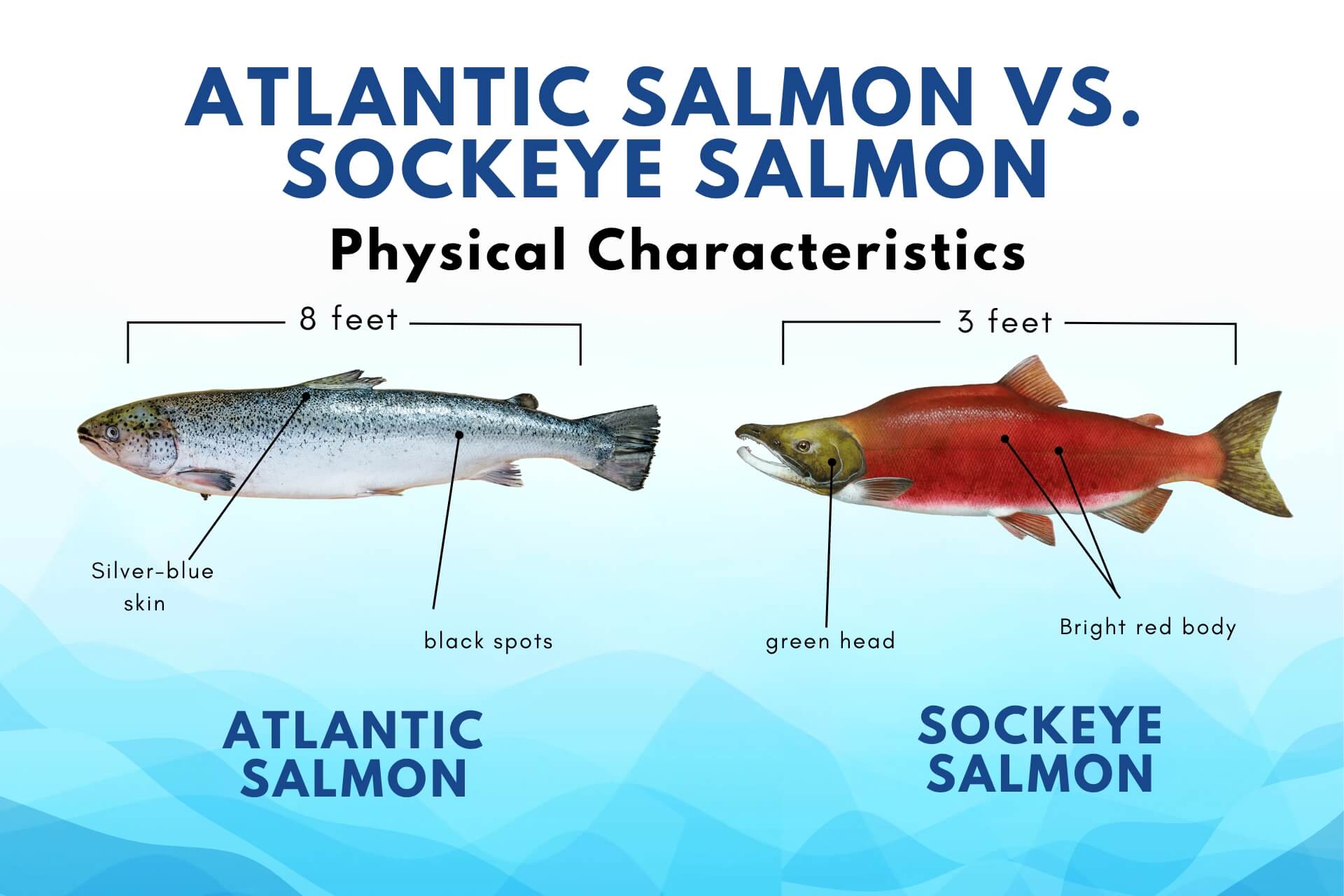
Pacific salmon, also known as Pacific Northwest salmon, is characterized by its distinct varieties and flavors. The three most popular varieties of Pacific salmon are chinook (also known as king salmon), coho (silver salmon), and sockeye (red salmon). Each variety has its own unique taste and texture. Chinook salmon is known for its rich, buttery flavor and tender flesh. Coho salmon has a milder flavor and firmer texture, making it versatile for various culinary uses. Sockeye salmon offers a deep, robust flavor and vibrant red flesh. These characteristics make Pacific salmon a popular choice for seafood lovers and culinary enthusiasts alike.
Pacific Salmon Varieties And Flavors
Pacific salmon offers a wide range of varieties, each with its own distinctive flavor profile. The three most popular types of Pacific salmon are chinook (or king salmon), coho (silver salmon), and sockeye (red salmon).
Chinook salmon is known for its rich, buttery flavor and tender flesh, making it a favorite among seafood enthusiasts. Coho salmon, on the other hand, has a milder taste and a firmer texture, making it versatile for various culinary uses. Sockeye salmon stands out with its deep, robust flavor and vibrant red flesh, making it a visually appealing and flavorful option. Whether you prefer a buttery melt-in-your-mouth experience or a bold robust flavor, Pacific salmon varieties have something to offer for every palate.
Pacific Salmon Culinary Uses
Pacific salmon, with its diverse varieties and flavors, is a highly versatile fish in the culinary world. Its firm texture makes it suitable for various cooking methods such as grilling, baking, broiling, or poaching. Pacific salmon is often used in popular dishes like salmon steaks, fillets, or sushi. Its vibrant red flesh adds a visually appealing touch to any dish. Pacific salmon can also be used in salads, pastas, or as a topping for pizza or sandwiches. With its rich flavor and versatility, Pacific salmon is a favorite choice for both home cooks and professional chefs.
Environmental Impact
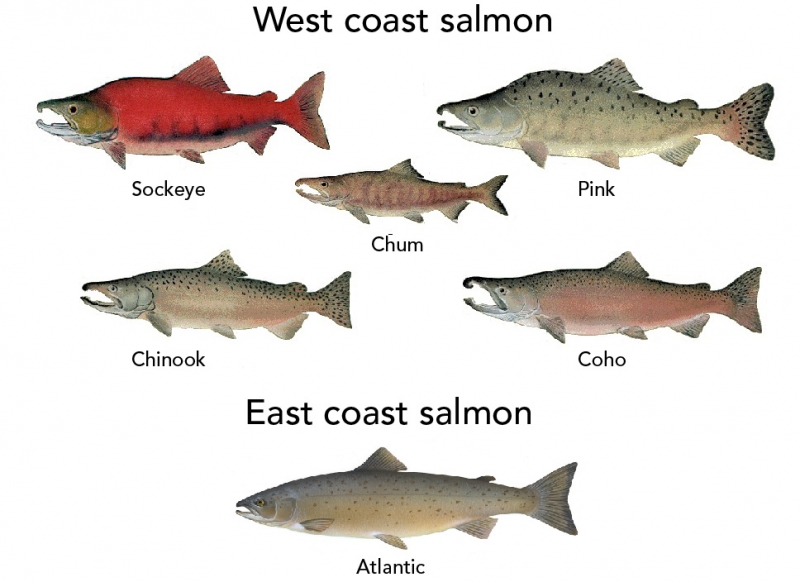
The environmental impact of salmon fishing and farming varies between Atlantic and Pacific species. Wild-caught Pacific salmon is generally considered more sustainable because they have natural diets and ecosystem roles, while Atlantic salmon farming raises concerns due to intensive farming practices and potential pollution. The use of antibiotics and fish feed can contribute to water pollution, and the escape of farmed salmon can impact wild populations. Sustainable fishing and farming practices, such as responsible sourcing and proper waste management, are crucial to minimize the environmental impact and ensure the long-term health of salmon populations.
Farming Practices And Sustainability
Farming practices play a significant role in the sustainability of salmon production. It is important to ensure that salmon farming is carried out in an environmentally responsible manner. This includes addressing issues such as water pollution, the use of antibiotics, and the sourcing of fish feed. Sustainable farming practices prioritize responsible sourcing, proper waste management, and minimizing the impact on surrounding ecosystems. By implementing these practices, we can reduce the environmental impact and ensure the long-term health of salmon populations. It is crucial to support salmon producers who prioritize sustainable farming methods to protect our oceans and the future of salmon fishing.
Wild Caught Vs Farmed Salmon
When it comes to choosing between wild caught and farmed salmon, there are several factors to consider. Wild caught salmon is sourced from natural environments such as rivers and oceans. It is prized for its rich flavor and firm texture, as well as its higher levels of omega-3 fatty acids and natural color. On the other hand, farmed salmon is raised in controlled environments, resulting in a more consistent supply and lower cost. However, it may contain higher levels of contaminants and artificial additives. Ultimately, the choice between wild caught and farmed salmon depends on one’s personal preferences and priorities in terms of sustainability and health benefits.
Cooking Methods
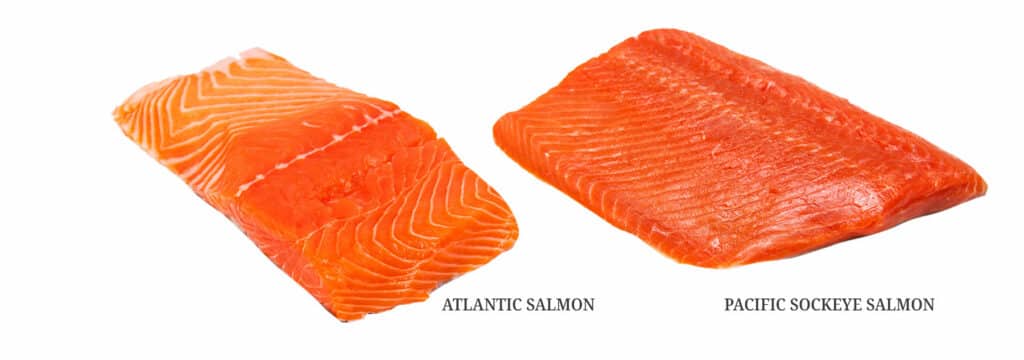
When it comes to cooking Atlantic salmon, there are many different methods to choose from. Grilling, smoking, baking, and pan-searing are just a few popular techniques. Grilling imparts a smoky flavor and beautiful grill marks, while smoking adds a rich flavor profile. Baking is a versatile option that allows for experimentation with different marinades and seasonings. Pan-searing is a quick and easy method that results in a crispy skin and tender flesh. No matter which method you choose, it’s important to cook the salmon until it is opaque and flakes easily with a fork.
Best Cooking Techniques For Atlantic Salmon
When it comes to cooking Atlantic salmon, there are several techniques that bring out its delicious flavors and tender texture. Grilling is a popular method that imparts a smoky flavor and creates beautiful grill marks. Smoking is another great option, adding a rich and distinctive taste. Baking is a versatile technique that allows for the use of different marinades and seasonings. Pan-searing is a quick and easy method that results in crispy skin and perfectly cooked flesh. No matter which cooking technique you choose, make sure to cook the salmon until it is opaque and flakes easily with a fork, ensuring a delicious meal.
Best Cooking Techniques For Pacific Salmon
Pacific salmon can be cooked using various methods to bring out its unique flavors and delicate texture. Grilling is a popular technique, allowing the salmon to develop a smoky taste while maintaining its moisture. Pan-searing is another great option, providing a crispy skin and tender flesh. Baking is versatile and allows for the addition of herbs and seasonings for added flavor. Poaching Pacific salmon in a flavorful liquid, such as broth or wine, is a gentle and delicious method. No matter the cooking technique chosen, it is important to cook the salmon until it is opaque and flakes easily to ensure a delightful dining experience.
Health Benefits
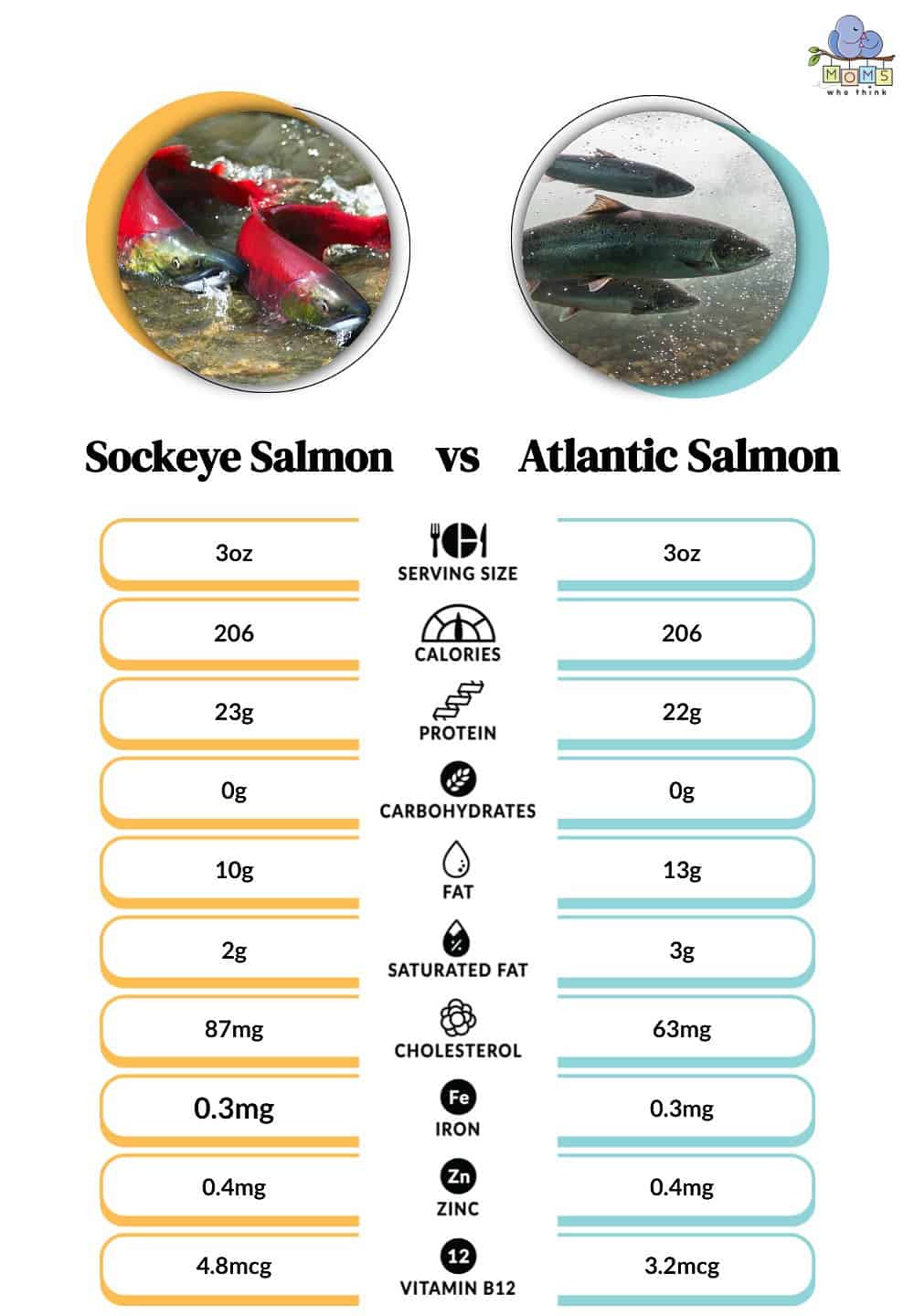
Consuming both Atlantic and Pacific salmon can provide numerous health benefits. Atlantic salmon is rich in omega-3 fatty acids, which are essential for brain health, reducing inflammation, and improving heart health. It is also a good source of protein, vitamins, and minerals. On the other hand, Pacific salmon is known for its higher levels of omega-3 fatty acids, as well as its lower levels of contaminants. These fatty acids can help reduce the risk of heart disease and improve brain function. Both types of salmon offer a delicious way to incorporate important nutrients into your diet and support overall health.
Health Benefits Of Consuming Atlantic Salmon
Consuming Atlantic salmon provides numerous health benefits. This type of salmon is rich in omega-3 fatty acids, which are essential for brain health, reducing inflammation, and improving heart health. It is also a good source of protein, vitamins, and minerals. Atlantic salmon contains high levels of vitamin D, which is important for bone health and immune function. Additionally, it is low in saturated fats and cholesterol, making it a heart-healthy choice. Including Atlantic salmon in your diet can support overall health and wellbeing.
Health Benefits Of Consuming Pacific Salmon
Consuming Pacific salmon provides numerous health benefits. This type of salmon is also rich in omega-3 fatty acids, which are essential for brain health, reducing inflammation, and improving heart health. It is high in protein, vitamins, and minerals. Pacific salmon contains high levels of vitamin D, which is important for bone health and immune function. Moreover, it is low in saturated fats and cholesterol, making it a heart-healthy choice. Including Pacific salmon in your diet can support overall health and well-being.
Conclusion
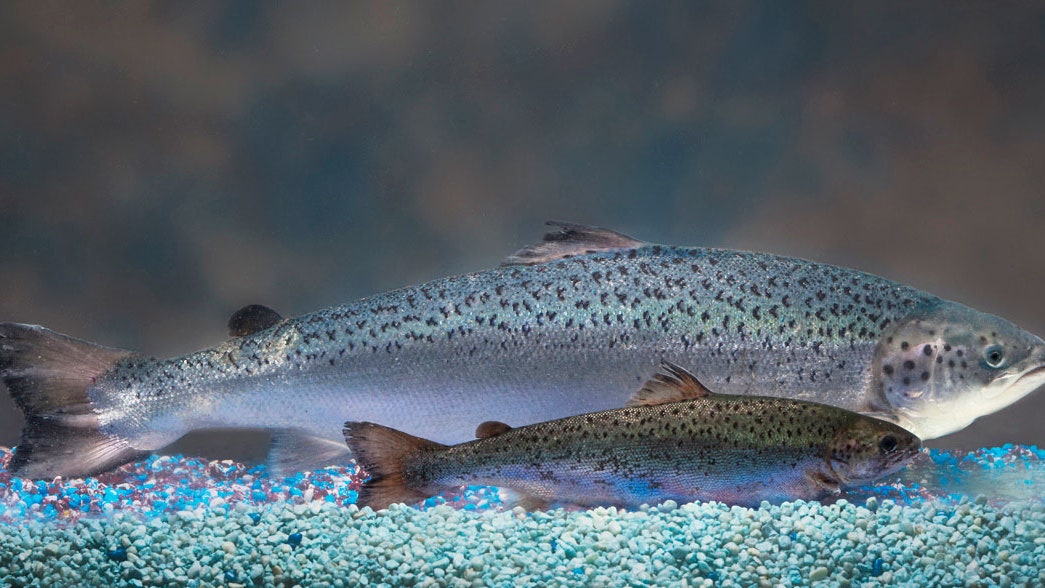
In conclusion, when it comes to choosing between Atlantic salmon and Pacific salmon, both options offer exceptional flavor and nutritional benefits. While Atlantic salmon is known for its rich and buttery flavor, Pacific salmon offers a variety of flavors depending on the species. Both types of salmon are packed with essential omega-3 fatty acids, protein, and vitamins. When making your selection, consider sustainability practices and whether you prefer wild-caught or farmed options. Ultimately, whether you go for the Atlantic or Pacific salmon, you can’t go wrong with these delicious and healthy choices.
Factors To Consider When Choosing Between Atlantic And Pacific Salmon
When choosing between Atlantic and Pacific salmon, there are several factors to consider. Firstly, location plays a role, as Atlantic salmon is commonly associated with fish farms in countries like Norway and Scotland, while Pacific salmon is mainly caught in the wild off the coasts of Alaska and Canada. Sustainability practices are also important, with wild-caught Pacific salmon generally being considered more environmentally friendly. Additionally, personal preference for flavor and texture should be taken into account, as Atlantic salmon tends to have a milder taste and softer texture, while Pacific salmon offers a variety of flavors depending on the species. Ultimately, the decision boils down to individual taste preferences, sustainability concerns, and availability.
Delicious Recipes To Try For Both Types Of Salmon
When it comes to cooking both Atlantic and Pacific salmon, there are endless possibilities for delicious recipes. For Atlantic salmon, you can try a simple yet flavorful grilled salmon with lemon and herbs or a creamy salmon pasta with garlic and Parmesan. For Pacific salmon, a popular choice is cedar plank salmon, which imparts a smoky flavor, or a zesty salmon poke bowl with fresh ingredients like avocado and cucumber. Whichever type of salmon you choose, these recipes will showcase the natural flavors and versatility of this beloved fish. So, get creative and explore the culinary world of salmon!
FAQ About Atlantic Salmon Vs Pacific: Choosing The Right Catch
Q: What are the main differences between Atlantic Salmon and Pacific Salmon?
A: Atlantic Salmon is typically farmed, has a milder flavor, and is fattier compared to wild-caught Pacific Salmon. Pacific Salmon, on the other hand, is usually wild-caught and has a richer, more pronounced flavor.
Q: Which is a healthier option, Atlantic or Pacific Salmon?
A: Nutritionally, both types of salmon are excellent sources of protein and omega-3 fatty acids. However, wild-caught Pacific Salmon generally contains fewer contaminants and has a more natural diet, making it a slightly healthier choice.
Q: How do I know if the salmon I’m buying is Atlantic or Pacific?
A: When purchasing salmon, check the labeling or ask your fishmonger where the salmon is from. Atlantic Salmon is typically labeled as such, while Pacific Salmon will specify the type (e.g., King, Sockeye, Coho).
Q: Can I substitute Atlantic Salmon for Pacific Salmon in recipes?
A: Yes, you can typically substitute Atlantic Salmon for Pacific Salmon in most recipes. Just be aware that the flavor and texture may vary slightly due to the differences between the two types of salmon.
Q: Which type of salmon is more sustainable?
A: In general, wild-caught Pacific Salmon is considered a more sustainable option as it is harvested in accordance with strict fishing regulations to ensure the long-term health of salmon populations. Atlantic Salmon farming practices vary in sustainability, so it’s essential to choose from reputable sources certified by sustainable seafood organizations.

ToroGrill Canada is excited to share our one-of-a-kind and authentic South American BBQ flavors with the wonderful people of Canada. Our journey began with a passion for bringing South America’s rich and vibrant culinary traditions to a new audience, and we have been dedicated to this mission ever since. Our story is one of inspiration, hard work, and the pursuit of excellence. Every recipe, every ingredient, and every cooking technique has been carefully honed and perfected to ensure that when you take a bite of our food, you experience the true essence of South American BBQ.